|
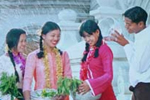
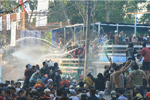 |
April: Tanku:
Thingyan(Festival of water pouring):
“Water festival” which lasts for
three days (generally speaking, from
13 April to 15 April) sounds mild to
describe a celebration especially in
the big cities. Pandals (temporary
shelter or shed) which entertain
with the music and dances, are built
on the roads and the streets from
which the merry makers actually
drench the passing cars and also the
passer-by with water using all the
available containers and even with
fire hoses. Merry makers, mostly
young people, go out cruising in
open pick-up trucks in order to be
able to fight back.
Since 2008, the government extended
the Thingyan holidays from 3 days to
10 days though the water festival
was held during the first three
days. Government offices and
businesses stop working during
Thingyan. |
|
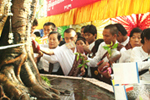 |
April/May: Kason:
(Festival of water pouring on Bo
trees): Myanmar people celebrate
the full moon day of Kason as the
day of the Buddha’s birth,
enlightenment and death. On that
day, the Bo and Banyan trees in all
the pagodas are ceremonially
watered. Festively dressed women
carry pots of water on their heads
to the sacred trees around the
pagodas and pour water over the
roots of the trees. |
|
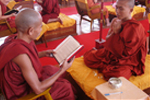 |
May/June: Nayon:
(Festival of examination): The
rain begins and it’s the end of hot
days. Examinations (for the Buddhist
monks) are held on the students’
knowledge of Buddhist scriptures. |
|
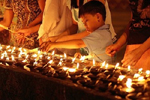 |
June/July: Waso:
(Festival of Buddhist lent): The
beginning of the three month
Buddhist lent. All monks go into a
deep retreat for study and
meditation. The monks are not
permitted to travel overnight during
this period. It is a custom to offer
robe to the monk during Waso.
Ordinary people are also expected to
be more religious during the lent.
Marriages do not take place and it’s
inauspicious to move house during
the lent. |
|
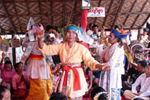 |
July/August:
Wagaung: (Festival of drawing lot):
The name of each member of local
sangah is written on a piece of
paper, which is then rolled up and
deposited into a large basket. A
representative from each household
of the community draws a slip of
paper from the basket, and the next
day, provides an elaborate feast for
the monk named on the piece of
paper. One layman will have drawn a
paper containing the name of hosting
the Buddha.
And the month of Wagaung, is the
time of the Nat festival in Taung
Byon, near Mandalay. The merry
makers there are allowed to verbally
tease the girls and women as they
please in this carnival atmosphere. |
|
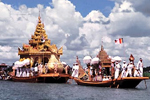 |
August/September: Tawthalin:
(Festival of boat race): By
September, rivers and streams are
full so boat races are held in
September. The most famous boat
races are held in Southern Shan
state at Phaung Daw Oo pagoda on
Inle lake. |
|
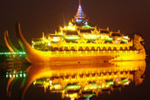 |
September/October: Thadingyut:
(Festival of lights): The
Thadingyut festival celebrates the
return of Buddha to earth from
heaven. Thadingyut marks the end of
Buddhist lent. And laymen are
allowed to wed till the next lent
begins. To symbolize the Buddha’s
return, houses, monasteries, public
buildings, and the streets are
illuminated with oil lamps, candles
and electricity.
This is the time when people give
particular reverence to their elders
and ask forgiveness for bad
behavior. |
|
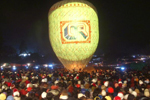 |
October/November: Tazaungmone:
(Festival of weaving): On the
full moon day of Tazaungmone,
unmarried girls work at their looms
from dusk to dawn to finish the
robes for the monks. These robes are
presented to the pagodas early next
morning.
And it is the time for Ka Htein
festival in which the monasteries
are showered with gifts such as
robes, fans, umbrellas, and clocks
etc |
|
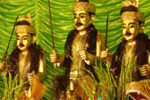 |
Novembar/December:
Natdaw: (Festival of the Nats):
When the full moon day comes,
celebrations dedicated to the spirit
world are held, in many parts of the
country. |
|
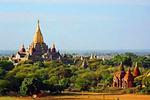 |
December/January: Pyatho:
(Festival of horse riding):
During the days of Myanmar kings,
Pyatho is the month when the
Noblemen and the Princes showed
their expertise in horse riding and
combat skills. Military parades were
also held to show off the King’s
military strength. Nowadays, local
pagoda festivals are held instead.
E.g. Ananda pagoda festival in Bagan. |
|
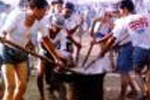 |
January/February: Tabodwe:
(Festival of Hta Ma Nair): To
mark the end of the harvest season,
glutinous rice was mixed with sesame
seeds, peanuts, shredded ginger and
shredded coconut and cooked over
open fire and stirred with big
wooeden paddles until they become a
thick mass which is called Hta ma
Nair which is wrapped in small
banana leaf, parcels and distributed
among all the members of the
community. |
|
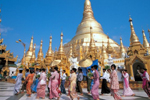 |
February/March: Tabaung:
(Festival of the pagodas): Full
moon day of Tabaung is the
auspicious day for construction of a
new pagoda. Pagoda festivals are
held on that day. E.g. Shwe Dagon
pagoda festival which is the largest
pagoda festival in Myanmar. |
|
|
▲Top
|